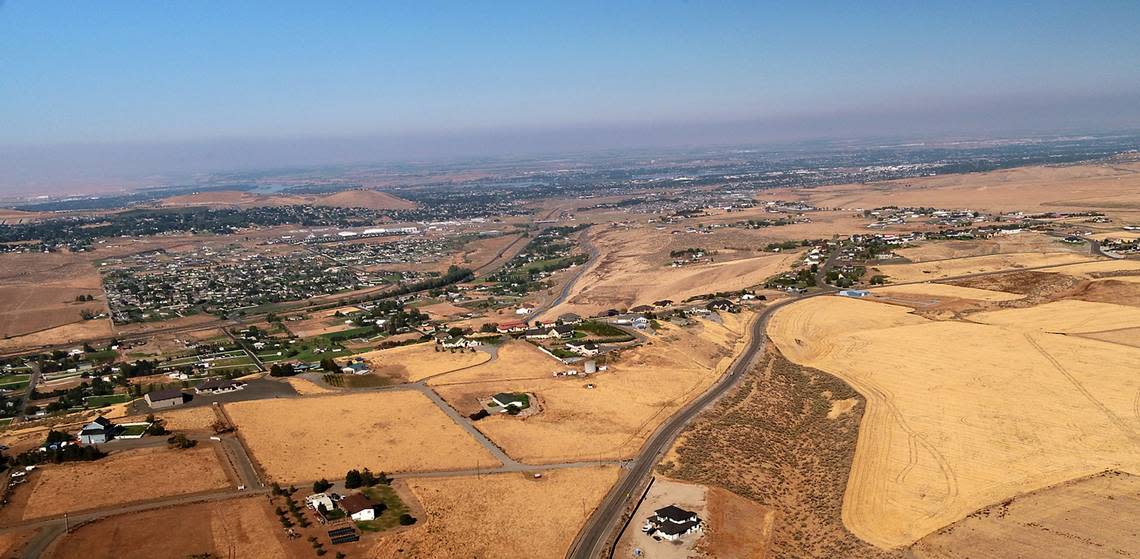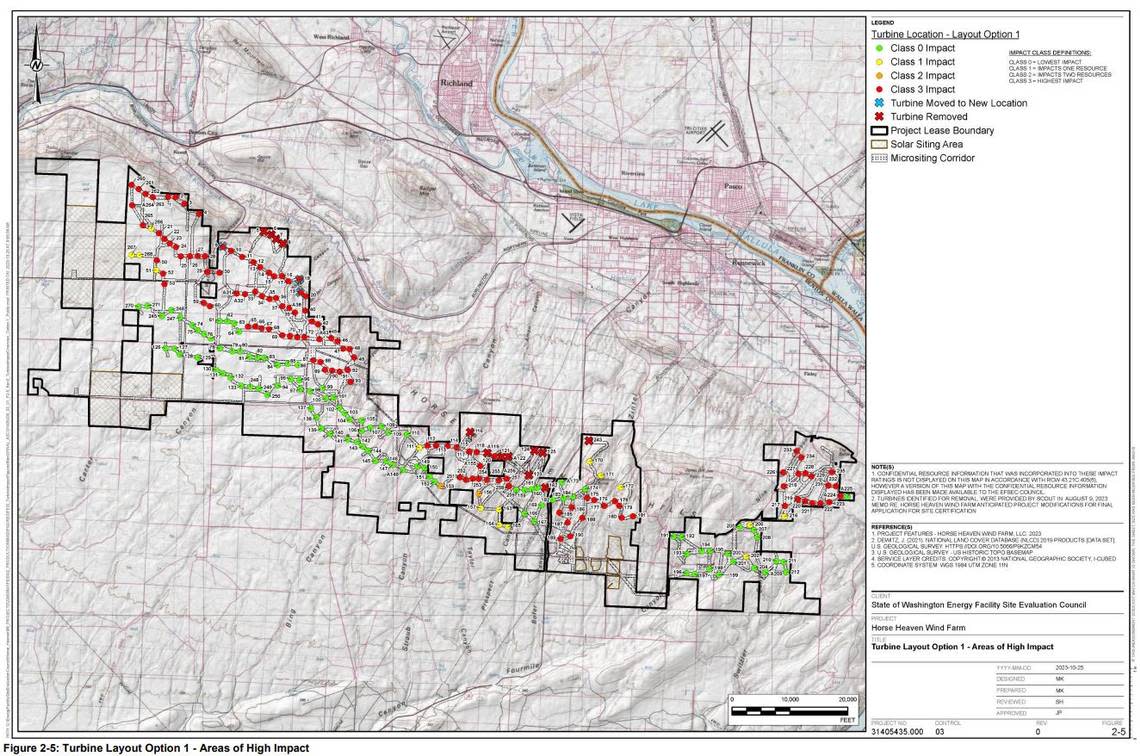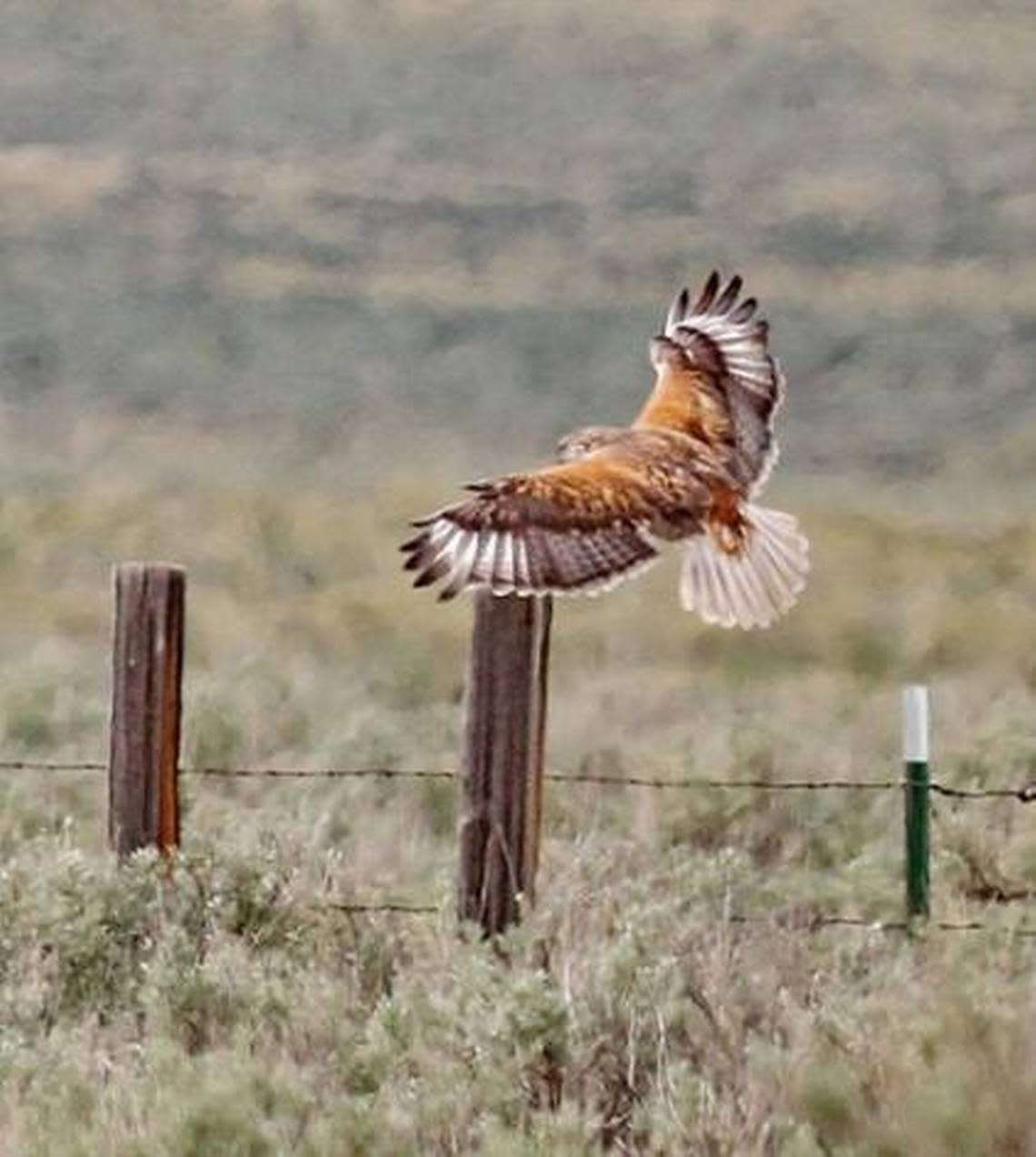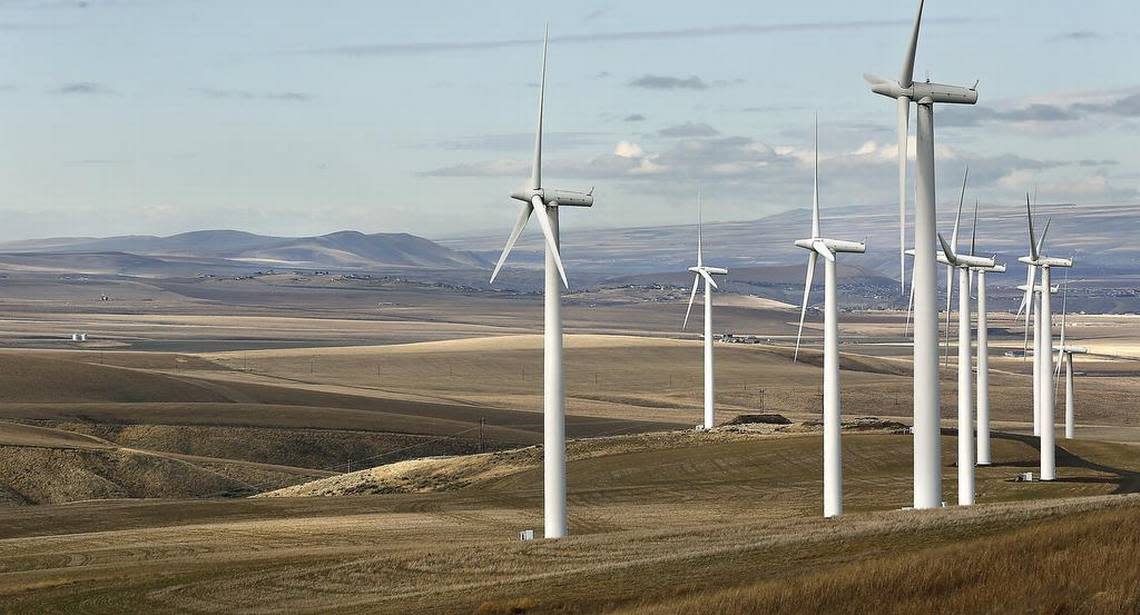WA council rules in split vote on huge Tri-Cities wind farm. Will Gov. Inslee agree?
A recommendation will be sent to Gov. Jay Inslee to approve construction of the Horse Heaven wind farm project just south of the Tri-Cities, but with possibly only half as many turbines as the developer envisioned.
The Washington state Energy Facility Site Evaluation Council, or EFSEC, voted Wednesday to recommend the project stretching along 24 miles of the Horse Heaven Hills, but with restrictions to protect the view from the Tri-Cities, Native American cultural resources and the ferruginous hawk.
Scout Clean Energy proposed the Horse Heaven Clean Energy Center be built with up to 222 turbines about 500 feet tall or 141 turbines about 670 feet tall, plus solar arrays and battery storage.
The council settled on a plan at the end of January to limit where the turbines can be built, effectively reducing their numbers by about half.
As originally proposed the turbines would have stretched from Finley to south of Benton City, dominating the southern views from the Tri-Cities.

EFSEC took public comment on a draft report prepared after that meeting to outline new restrictions and received 973 comments.
Comments were split mostly among people who said the proposed restrictions were still insufficient and people who said the proposed restrictions went too far.
The state council vote was split 5-2, with representatives of Benton County and the Department of Natural Resources opposed. The Department of Natural Resources plans to submit a statement explaining its opposition.
Areas where turbines would no longer be allowed would be some of the places most visible from the Tri-Cities, including upper slopes of the Horse Heaven Hills.
The project is expected to need a substantial redesign by Scout Clean Energy to comply with restrictions on where turbines can be built, said EFSEC staff.
Inslee should receive the EFSEC recommendation before the end of the month.
He will have 60 days to review and approve the council recommendation for the construction of the wind farm with restrictions, reject the application or direct EFSEC to reconsider aspects of the project.
However, petitions for reconsideration may be filed with EFSEC within 20 days of when the governor receives the recommendation.
Opposition to wind turbine cuts
“By partially approving the Horse Heaven wind and solar project, EFSEC is balancing the need for renewable, clean energy with potential impacts on tribal cultural resources, wildlife, and surrounding communities,” said EFSEC Chairperson Kathleen Drew in a statement after the council vote.

A coalition of Tri-Cities area Democrat groups and trade unions warned before the Wednesday meeting that the restrictions being proposed by EFSEC to protect ferruginous hawks could set precedent that would prevent new clean energy projects and transmission infrastructure projects in Central and Eastern Washington.
“... if EFSEC persists with its current trajectory, it will send a clear signal to other investors and project developers that Washington state is by far not the location in which to reliably and affordably site the clean energy generation required under state law,” they said in comments to EFSEC.
“The result will be more out-of-state projects, costlier transmission and higher utility rates for every person in Washington, in addition to the foregone benefits of new jobs, local economic impact and taxes generated,” they said.
Ed Brost, representing Benton County, asked for information about who the power from the Horse Heaven project would be sold to, but was told that was not something that EFSEC considers.
Ferruginous hawks in Washington
Scout Clean Energy submitted 60 pages of comments opposing restrictions, saying that two-mile buffers required around places where ferruginous hawks have nested historically “eliminates a majority of the clean energy benefit” even though nesting has rarely been documented there in the last decade.
EFSEC earlier determined in an adjudicative order that loss of shrub-steppe habitat is already affecting ferruginous hawks in Washington state and that the clean energy project as proposed by Scout would pose a new and significant threat to the state endangered species.
Proposed restrictions on the project could increase the ability of the hawks to return to certain areas of historic usage, according to the EFSEC draft report for the governor.
More than 60% of the nesting territories of the ferruginous hawk in Washington state is concentrated in Franklin and Benton counties, which is considered the core breeding range in the state, according to the Washington state Department of Fish and Wildlife’s 2021 status review of the ferruginous hawk.
It said that an average of 55 breeding pairs per year nested in the state between 1992 and 1995.

Gerald Lewis, chairman of the Yakama Nation Tribal Council, reminded EFSEC in a March letter that the recommendation for a two-mile buffer for ferruginous hawk nests was developed by Washington state Department of Fish and Wildlife experts. The recommendation follows the best available science, he said.
It was a compromise on the part of biologists because ferruginous hawks’ average core use areas are more than six miles, Lewis said in his letter to EFSEC.
Washington Audubon said in its comments to EFSEC that it supported approval of the project with restrictions to project ferruginous hawks, corridors used by wildlife and rabbitbrush shrubland. But it questioned whether enough had been done to reduce impacts to tribal cultural properties.
The same care and consideration that was shown in the council’s discussion on ferruginous hawks also should be given to the protection of cultural resources, Lewis said.
The Yakama Nation had asked that all turbines, solar arrays and infrastructure east of Straub Canyon, which is south of Richland, be prohibited to protect tribal cultural resources. The council considered that restriction in January, but failed to get a majority of council members in support.
Tri-Cities CARES: Too many turbines
Tri-Cities CARES, a grassroots group opposing the Horse Heaven wind farm, has argued that the wind farm, even with restrictions proposed in January, would have too many turbines.
Between the Horse Heaven wind farm and the nearby and smaller Nine Canyon wind farm, just over 100,000 residents of Benton County would live within six miles of a turbine as the project was originally proposed, according to Tri-Cities CARES.
That’s five times more than the estimated 20,000 people who live within six miles of a wind farm across the rest of Washington state, the group said.

Other Washington state counties with wind farms average about 2,000 people living within six miles, according to Tri-Cities CARES.
The conclusion of EFSEC’s recommendation said restrictions on the project’s wind turbines would not fully mitigate impacts to landscape and other natural features in and around the project site that the Yakama Nation has identified as having special cultural significance.
But reasonable measures have been proposed to minimize impacts and balance them with the benefits of encouraging development of clean energy, it said.
